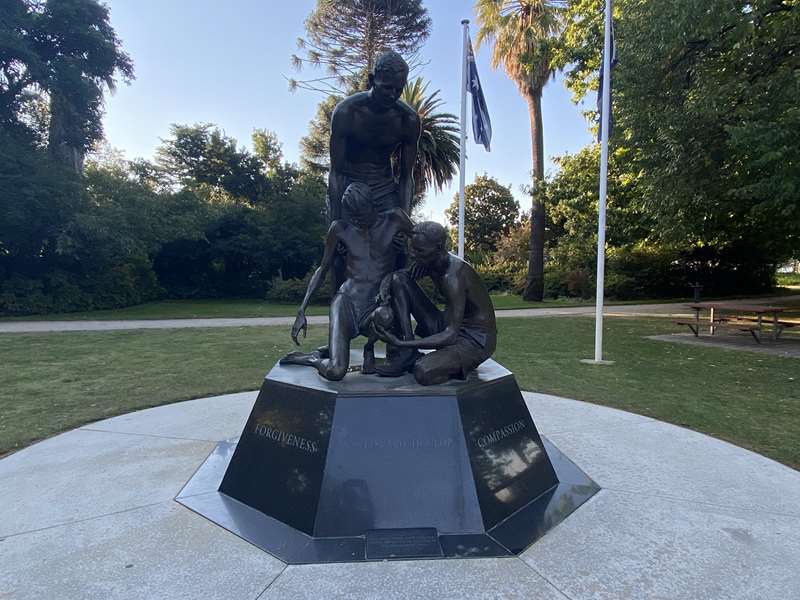Benalla - Weary Dunlop Memorial


The Weary Dunlop Memorial is located in the Benalla Botanical Gardens.
Introduction
Sir Edward Dunlop is acknowledged as an Australian hero. A man of deep personal integrity. To many he was affectionately known as "Weary".
His extraordinary life is commemorated with a memorial sculpture in the Benalla Botanical Gardens.
Early years
Weary grew up on his family's farm 25kms north west of Benalla at Sheepwash Creek, Stewarton. A brilliant student and accomplished sportsman, he studied pharmacy and later moved on to medicine at the University of Melbourne before becoming a surgeon. He played rugby for Australia and proceeded to England to complete his medical studies.
World War II
At the outbreak of war in 1939. Weary volunteered as an Army Surgeon. He served in Greece (Crete), Palestine and Egypt before transferring to Java.
In March 1942 the Japanese captured the hospital where he was stationed. Rather than escaping, he chose to stay with his patients. As a result. he was interned for more than three years as a prisoner of war.
In the prison camp, Weary found himself commanding officer and surgeon responsible for more than 1,000 men on the notorious Thai-Burma Railway. Conditions on the railway were severe. Starvation and disease, including cholera. malaria and dysentery, decimated a group of men already weak with exhaustion. An estimated 150,000 POWs and Asian labourers died during the construction of the 400 kilometre railway. It is here at the "Death Railway" that Weary's personal resources were tested.
"I have a conviction that it's only when you are put at full stretch that you can realise your full potential"
As a leader, Weary displayed incredible courage, often putting his own life at risk on behalf of men under his command. With few medical supplies and almost no instruments, he and his troops ran an effective military hospital, improvising equipment, such as blunted needles and artificial limbs from bamboo and intravenous drips from beer bottles. Their resourcefulness often meant the difference between survival and death.
After the war
Despite his brutal treatment as a prisoner of war, Weary was still able to feel compassion for his enemy as the preface to his War Diaries shows:
"I was confronted by a train-load of Japanese casualties...I paused before a man whose wretchedness equalled the plight of one of my own men - one leg had been hacked off at the mid-thigh and the bone stump projected through gangrenous flesh: his eyes were sunken pools of pain in a haggard, toxic face. With indomitable spirit he had hopped...hundreds of suffering miles without care. Some bombs fell and soldiers desperately fought for a place on the moving train. I moved to help him when he was trampled under in the rush, but his hand was limp and dead, and the tortured face at peace. The memory dwelt with me as a lingering nightmare and I was deeply conscious of the Buddhist belief that all men are equal in the face of suffering and death."
Weary returned to Australia in 1945. dedicating his life and career to caring for former prisoners of war. He went on to become a pioneering cancer surgeon and taught throughout Asia under the Colombo Plan. He was involved with the Australian-Asian Association and the Weary Dunlop Boon Pong Exchange Fellowship, which enabled young Thai surgeons to study in Australia.
Sir Weary Dunlop died on 2 July 1993.
The Memorial
To mark his achievements the people of Benalla commissioned a memorial sculpture. Cast in bronze and standing two metres high, the memorial stands on a granite-faced plinth. The words engraved on the granite facings are: compassion, integrity, forgiveness, humility, courage, leadership, friendship
Celebration of life
Rather than presenting a conventional portrayal of a standing figure upon a pedestal, the sculptor, Louis Laumen, sought to depict Weary Dunlop stooping over the stricken figure of a POW - shoring up his failing strength - as a second doctor commences to tend the abused body. The injured man is placed at the centre of the composition to reflect the centrality of the plight of POW's in Weary's life long work.
Weary's special genius was to organise, to oversee and to inspire. Hence the portrayal of his tall gangling body bowed over the others. The figures are garbed in the poverty and distress that was the grim reality of their enslavement in the time of the notorious Thai-Burma Railroad. The work depicts an overwhelming sense of compassion.
A powerful experience
Viewing the sculpture is a powerful experience, due in part to its setting. The location, selected by the artist, is a tranquil site in the Benalla Botanical Gardens. As a viewer, you are invited to stop for a moment and reflect on the sculpture and the life it celebrates.
"When despair and death reached out to us Weary Dunlop stood fast, a lighthouse of sanity in a universe of madness and suffering." Donald Stuart (2/3rd Machine Gun Battalion)
With gratitude
The memorial was built through the generosity and enthusiasm of the Australian people, and especially those of Benalla and District, in appreciation of the life of Sir Edward Dunlop.
The Weary Dunlop Memorial was officially unveiled in Benalla on 10 November, 1996 by the Hon. John Howard MP, the then Prime Minister of Australia.
Photos:
Location
1 Bridge Street West, Benalla 3672 View Map









